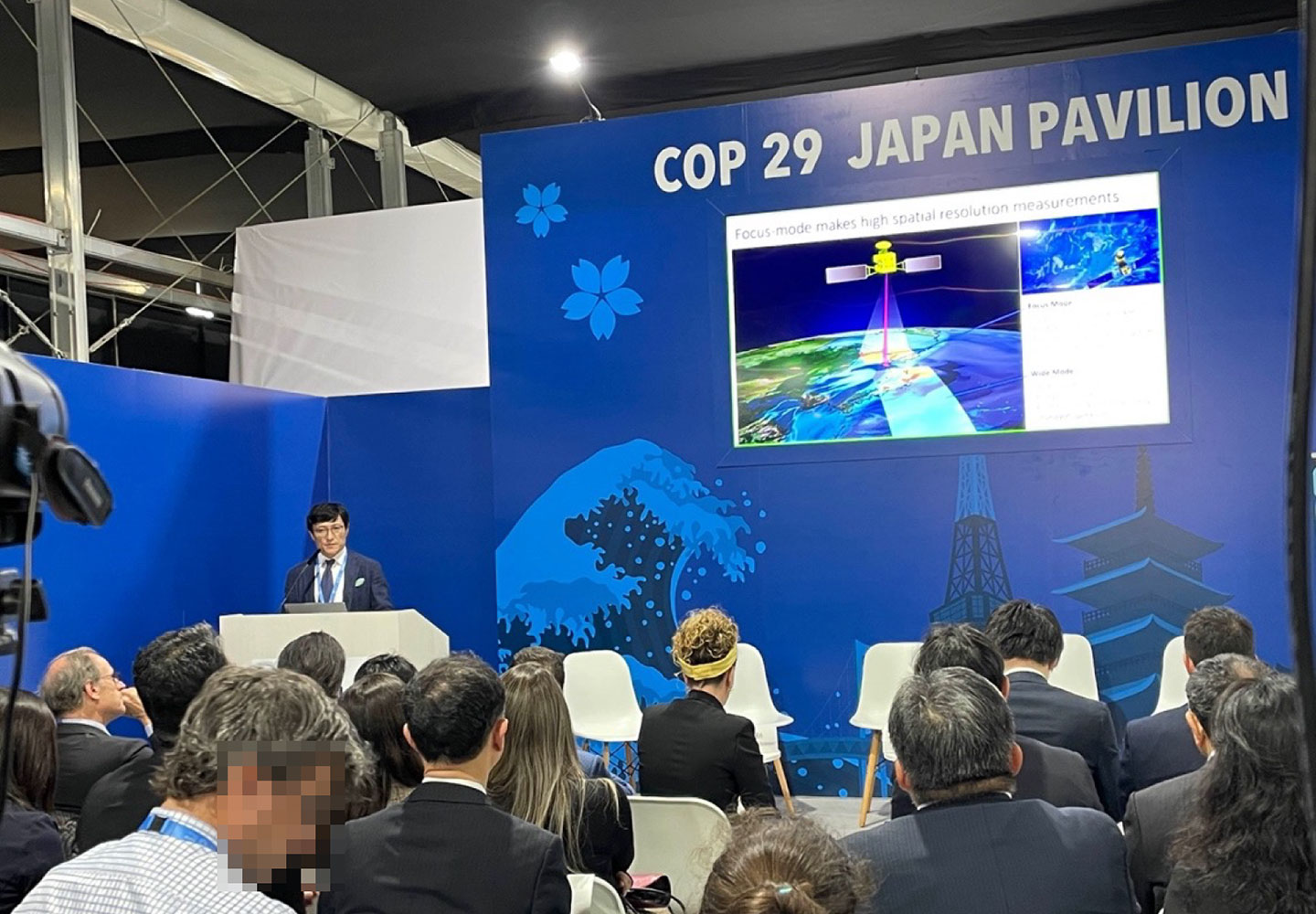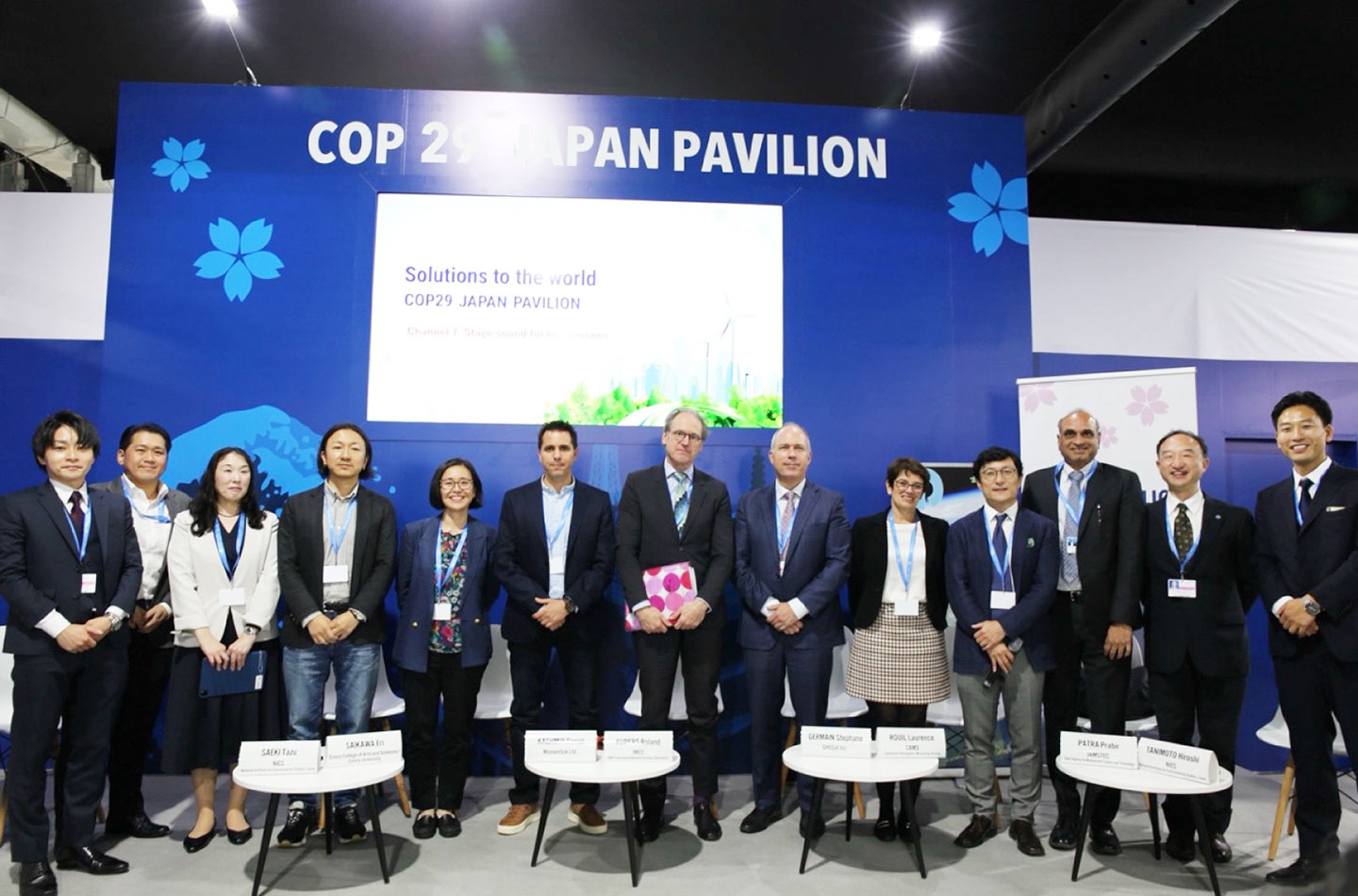COP29 in Baku: Seminar at Japan Pavillion and Earth Information Day 2024
Seminar at the Japan Pavillion
November 14th (local time 15:45 – 17:00), COP29 Day 4, the Ministry of the Environment, Japan (MOEJ), the National Institute for Environmental Studies (NIES), and the Japan Agency for Marine-Earth Science and Technology (JAMSTEC) co-organized a seminar entitled “New Developments of GOSAT (Greenhouse gases Observing SATellite) Series - Japanese GHG Center and Use of Satellite Data for Business” at the Japan Pavillion (Blue Zone, Zone E, C-5). As part of the climate action towards Net-Zero, the seminar's main objective was to highlight the GOSAT series, specifically the GOSAT-GW (Global Observing SATellite for Greenhouse gases and Water cycle) mission and the use of GOSAT data for the business sector. Like the previous years since COVID-19 spread, this year’s seminar was also conducted in a hybrid format with six speakers followed by a panel discussion. From NIES, Deputy Director Tanimoto and Senior Researcher Saeki took part as speakers, and the author and Section Chief Kawajiri were in charge of seminar logistics.

As expected, many are looking forward to the GOSAT-GW seminar, at the opening, the attendance was more than the provided seats available (40 at the Japan Pavillion) thus, many left standing around the venue (including a few of the panel discussion members). Saeki moderated the opening and talk sessions. The opening address was given by Yutaka Matsuzawa, Vice Minister for Global Environmental Affairs, MOEJ, and which also acknowledged the attendance of Idit Silman as the Minister of Environmental Protection, Israel

The first speaker was Tanimoto with a talk entitled “GOSAT-GW Satellite and Planning of the GHG Center in Japan”. Two exciting pieces of news were shared, first on the GOSAT-GW satellite mission and second on planning for the Japan GHG Center. The second speaker was Yugo Kanaya, director of Earth Surface System Research Center, JAMSTEC, with a talk entitled “Advanced Modeling and Flux Estimation Systems to Support Satellite Observations”. As the full house seminar progressed, it transitioned into the business sector which following talk was given by Masahiro Naka, Deputy Director for Energy Diplomacy and LNG Policy, Ministry of Economy, Trade and Industry focused on “Coalition for LNG Emission Abatement toward Net-zero”. Next, Kay Yano the Co-founder of Carbontribe Labs OÜ presented a talk on “Carbon Credit Generation Utilizing GOSAT Data,” and Keisuke Yano from SOMPO Japan Insurance Inc. together with Daniel Kashmir, CEO Momentick Ltd. delivered a talk entitled “Satellite-Based Methane Emission Detection for Risk Management”. The last talk, entitled “Navigating Sustainable Finance: How Satellite Data Guides Our Journey to the Future” was also co-presented by two speakers, Takumi Hashizume Managing Director from MUFG Bank, Ltd., and Stephane Germain, the founder and CEO GHGSat Inc.

Following talks by experts was the panel discussion moderated by Tanimoto. Seven experts from across the globe participated in the discussion, included Prabir Patra (Principal Scientist, Earth Surface System Research Center, JAMSTEC), Laurence Rouil (Director, the Copernicus Atmosphere Monitoring Service), Stephane Germain (Founder and Chief Executive Officer, GHGSat Inc.), Roland Kupers (Lead Architect, UNEP International Methane Emissions Observatory), Daniel Kashmir (CEO, Momentick Ltd.), Eri Saikawa (Professor, Emory University) and last but not least Saeki. All experts introduced the use of the GOSAT series data in various fields, plus the potential integration of GOSAT-GW in their upcoming work. As many interesting inputs were introduced by the experts, at the end of the panel discussion, Gianpaolo Balsamo (Director of G3W at the World Meteorological Organization) asked what the plan for the long-term conservation of earth observation data so to be able to inform the Paris Agreement. Stephane responded by highlighting that the United Nations is one of the key repositories for GHGSat, Laurence suggested what’s important is a sustainable system and lastly, Prabir added that currently, GOSAT data is archived version by version with updates that are available for download.

Overall, the seminar attracted more than a hundred onsite and online attendees (total). Tanimoto wrapped up the seminar by delivered a closing address followed by a group photo. The seminar concluded as scheduled, and finally, we would like to express our gratitude to the Ministry of the Environment for providing us with the opportunity to conduct the seminar and to the Japan Pavilion Secretariat for managing the event. Everyone left the venue with excitement.
Related Seminar Attended
On November 11th (local time 13:00 – 16:00), COP Day 1, Saeki, Oda (previously worked as a special researcher at NIES, currently a member of the USRA in the United States) and the author attended the Earth Information Day (EID) 2024 – Mandated event at plenary – Caspian, Area D of COP29 venue. In general, Earth Information Day (EID) provides a platform for dialogue, enabling the exchange of information on the state of the global climate system and advancements in systematic observation (FCCC/SBSTA/2019/2 para. 58), as quoted from the UNFCCC website (https://unfccc.int/topics/science/events-meetings/earth-information-day). Indeed, at such a high-level event, EID 2024, we witnessed panel updates on the states of the climate, including “WMO 2024 State of the Climate Update” by John Kennedy and Blair Trewin from the World Meteorological Organization, “Updates on the Global Climate Observing System” by Thelma Krug, Global Climate Observing System chair, “Global Greenhouse Gases Monitoring and Research” by Gianpaolo Balsamo, G3W, World Meteorological Organization, “Early Warning for All initiative” by Ko Barrett, WMO Deputy Secretary General, “Bridging observation gaps, role of SOFF and innovative financing models” by Markus Repnik from Systematic Observations Financing Facility (SOFF), “Country experiences on SOFF” by Lucy Mtilatila from DCCMS Malawi and finally “Advancements in technology and innovation, including the role of AI and machine learning in Earth observation” by Rob Redmon from NOAA Center for Artificial Intelligence. Following the panel updates session, there were breakout sessions in which two prominent Japanese scientists, Yugo Kanaya from JAMSTEC and Akihiko Ito from University of Tokyo/NIES, took part in the “Observations for Climate Change Mitigation” topic session. (Links for details: https://unfccc.int/event/earth-information-day-2024-mandated-event)
